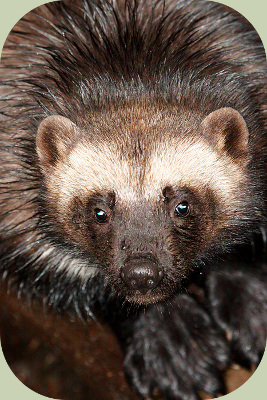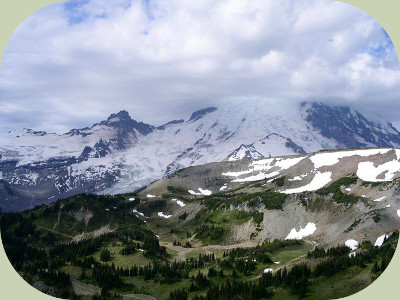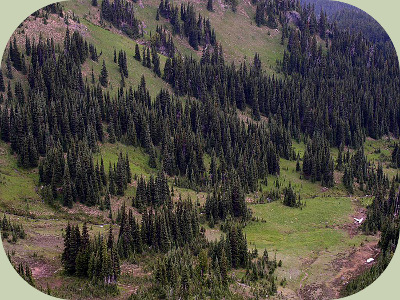Recognizing Wolverine Habitat

Learning to know what makes good wolverine habitat can help you increase your odds of seeing this extremely elusive member of the weasel family. Wolverines have seemingly boundless energy, can cover many miles in the course of a day and have an incredible ability to locate the carcasses of winter killed animals even under several feet of snow.
Wolverines are known to have a different approach to obstacles than other creatures. When a mountain stands in their way, they climb right over it instead of going around. When they locate the kill of a cougar or bear, they will not hesitate to fight with those much bigger and stronger predators for their prize. Wolverines have a near-mythical reputation for toughness and resilience.
What makes good wolverine habitat?
Wolverines are creatures of cold, snowy landscapes. Habitats where they might be found are: arctic tundra, alpine meadows, subalpine forests, snow fields and northern boreal forests. Wolverines are found both in the boreal and arctic regions of North America, as well as Scandinavia and Northern Asia.

What do wolverines eat?
Wolverines are carnivores, feeding on a variety small to medium sized animals including: ground squirrels, marmots, voles, hares, ptarmigan, grouse, deer and caribou. Wolverines are also keen scavengers, with powerful jaws that can crush bones and frozen carcasses. In mountainous areas, wolverine habitat often includes avalanche paths, where frozen animals can provide a feast for a wolverine.
Be More Prepared For Your Next Outdoor Adventure!

Don't leave without knowing these six essential survival skills. Our free survival mini guide reveals the strategies of:
- Shelter & fire to prevent the number one cause of death
- Obtaining clean water to avoid life-threatening dehydration
- Common wild survival foods and other critical skills!

How do you know a wolverine is around?
When you are in the appropriate wolverine habitat, there are certain things you can look for to help you to determine if a wolverine is around. Given the elusive nature of the wolverine, it is vital to be able to recognize their tracks and sign.
Tracks: The tracks of a wolverine are large, long toed and can be widely splayed in deep snow or mud. Tracks have 5 toes on both fronts and rears, though sometimes the smallest toes do not register clearly. Smallest, lowest toe is on the inside. The metacarpal pads are asymmetrical and strongly lobed. They travel in a walk or a 3 x 4 lope. Loping strides measure 7 – 45 inches long. Walking strides measure 8 – 15 inches long. The trail width measures between 7 and 10 inches. They can travel great distances over very rugged terrain.
Front Tracks: Measure 3 5/8 – 6 1/4 inches long by 3 1/2 – 5 1/4 inches wide. Five toes, nails sharp and may or may not register. Space between toes and metacarpal pad is very furry and may affect shape and detail of tracks.
Rear Tracks: Measure 3 5/8 – 6 inches long by 3 1/4 – 5 1/4 inches wide. Five toes, nails sharp and may or may not register. Space between toes and metacarpal pad is very furry and may affect shape and detail of tracks.
Scat: Cylindrical, 3/8 – 1 inch in diameter and 3 – 8 inches long. The scat can contain bones, fur and feathers.
Other sign: Wolverines exhibit other behaviors such as rolling on other animal’s trails and scent posts. They will also bite, mark and climb small saplings, breaking limbs and defoliating them. Wolverines are good climbers, and may occasionally leave claw marks on trees they have climbed.
Similar tracks: Large domestic dog tracks can look similar, when the fifth toes of the wolverines feet do not register clearly. Dogs have symmetrical tracks, four toes with blunt claws and a triangular, relatively symmetrical pad. Small bear tracks look different due to their very large metacarpal or heel pads.
Closing Thoughts
Take time to get to know wolverine habitat if you wish to better know the wolverine. Keep your eyes open for the tracks and sign of these wild, wide-ranging members of the weasel family. Wandering through the beautiful, wild alpine meadows, boreal forests, impressive mountains and tundra habitat that is home to the wolverine can be its own reward.
By the way, when you're out tracking or looking for wild animals, it's important to know how to stay safe in the outdoors, especially if you were to get lost. Right now you can get a free copy of our mini survival guide here, where you'll discover six key strategies for outdoor emergencies, plus often-overlooked survival tips.
Further Resources
Related Courses:
Additional resources on the wolverine can be found here:
Resources: Elbroch 2003, Eder 2002 and Reid 2006.


About the Author: Filip Tkaczyk is a periodic guest teacher at Alderleaf. He also wrote the field guide Tracks & Sign of Reptiles & Amphibians. Learn more about Filip Tkaczyk.
Return from Wolverine Habitat back to Wildlife Tracking Articles
Is The Essential Wilderness Survival Skills Course Right for You? Take the "Online Survival Training Readiness" Quiz
See for yourself if this eye-opening course is a good fit for you. It takes just a few minutes! Get your Survival Training Readiness Score Now!

Grow Your Outdoor Skills! Get monthly updates on new wilderness skills, upcoming courses, and special opportunities. Join the free Alderleaf eNews and as a welcome gift you'll get a copy of our Mini Survival Guide.

 The Six Keys to Survival: Get a free copy of our survival mini-guide and monthly tips!
The Six Keys to Survival: Get a free copy of our survival mini-guide and monthly tips!
Learn more